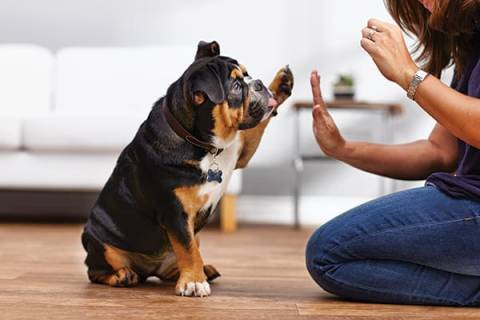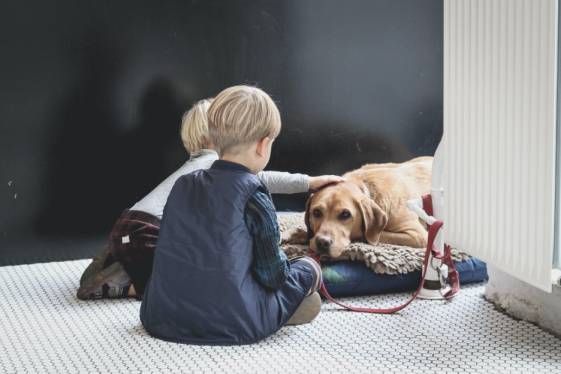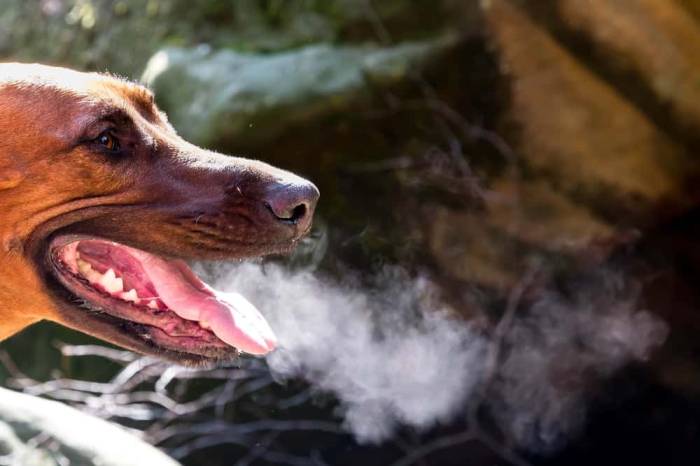It’s sometimes a bit scary when your dog goes off to be spayed. You can’t help but worry. But rest assured this is a very common medical procedure. Your fur baby will be more comfortable and healthier after surgery. For instance, you won’t have to worry about uterine or ovarian cancer in your dog.
Connect with a verified veterinarian in minutes. Licensed vets are available 24/7 to answer your questions. No need to worry about your furry family member.
In addition, spaying also keeps your dog from becoming pregnant. That can be a somewhat sad thought; however, it’s better not to bring more puppies into the world. There’s an overpopulation of dogs and other animals and it’s more difficult to find homes for them. So, spaying helps you keep from adding more unwanted pets into the mix.
While this is a regular operation, spaying is considered a major surgery. So, the recovery time is longer in female dogs than in male dogs. Spaying involves removing the uterus and the ovaries. This means the surgery involves going inside your dog’s abdomen. This is why the post-operative healing is longer in females than in male dogs.
Why Have my Dog Spayed?
As mentioned earlier, spaying your dog will not add more puppies and unwanted dogs to our current pet overpopulation issue. There are many puppies and dogs that are euthanized because they aren’t able to find a home. So, having your dog spayed prevents the birth of unwanted puppies.
Don’t worry that this surgery will in some way diminish your dog’s intelligence, have an effect on her personality, etc. In fact, spaying can keep your fur baby healthier over the course of her life.
What is Spaying?
Spaying is the common term used for the surgical removal of a female dog’s uterus and ovaries. The medical term for this type of surgery is called an “ovariohysterectomy.” The surgery is used to completely sterilize a female dog.

Review symptoms, medications & behavior to keep your pets healthy with a Vet Online in just minutes.
Ask a Vet Live NowWhat are the Benefits of Spaying?
There are many benefits to having a dog spayed. These include:
- End of the estrus cycle (heat)
- Eliminates hormone fluctuation
- Prevents uterine infection
- Prevents breast cancer
- Prevents uterine and ovarian cancers.
- Spayed dogs have a longer life than those who are not spayed.
- Reduces a dog’s chance of developing separation anxiety or becoming fearful.
When Should Spaying Be Done?
Veterinarians tend to recommend that dogs be spayed between the age of four to six months. However, there can be some reasons a vet may choose to spay a dog after this period.
So, always be sure to check with your vet to see when they recommend your dog be spayed.
What are the Risks Involved with Spaying?
One of the biggest risks involves the use of general anesthesia. Most of the time, anesthesia doesn’t cause any complications. However, there’s always a chance it may cause complications or even death in some instances. These instances are rare.
Before the surgery, your vet will perform blood tests to make sure it’s safe to anesthetize your canine companion. In most cases, the dog will receive an IV or catheter through which the medication is given during surgery. The vet will also use a breathing tube to oxygen the anesthetic directly to the dog’s lungs.
What Does the Surgery Involve?
The surgery consists of the vet making an incision just below your fur baby’s umbilicus. Then the vet will be able to remove the ovaries and the uterus. After the surgery is over, the vet will then use stitches to close your dog’s abdomen. The type of stitches the vet chooses to use may include staples, absorbable sutures, or thread.
Post-operative Precautions
After the surgery, your fur baby will need to be quiet, so she can heal. This means that your dog will not be able to run, jump, or walk far during the healing process. In addition, your canine friend may also need to wear one of the dreaded Elizabethan collars. This will keep her from biting at her incision, which could lead to the stitches opening or the wound becoming infected.
How Soon Can my Dog Exercise After Being Spayed?
First, we must mention that it’s extremely important to follow your vet’s guidance on exercising your dog after she’s spayed. This is because each dog is unique, which means that each dog has different health issues to consider after the surgery. So, be sure to follow your vet’s guidance and instructions on how to care for your dog. The information we provide here is only to give you a general idea of exercising after surgery.
For the most part, veterinarians usually recommend waiting until 24-48 hours after surgery. During this time, you can take your dog on a leash and allow her to gently roam the backyard. Keeping her on a leash, even in the yard, is just to keep her from jumping, running, and more.
After the initial 24-48 hours, vets usually advise short walks with your dog. The usual recommendation is about 25% of your dog’s normal walk at this time. The walks should stay more sedate until you see the vet again. The next visit is usually 10-14 days after surgery, as this is the time the vet will remove the stitches (unless they’ve used stitches that are absorbed).
When the stitches are removed, the vet may say your dog’s completely healed or will provide instructions for exercise if your dog is not quite healed up. Remember, even after the stitches come out, your dog will still be healing inside. So, in some cases, it may be necessary to keep to a gentler walk until the vet gives the all-clear for longer bouts of exercise.
Again, remember the information here is only for general guidance. Remember to follow your vet’s instructions when it comes to caring for and exercising your fur baby after her surgery.
Keep the Wound Covered
You may want to ask the vet if the wound needs to be covered when you and your canine companion are out and about. Some vets do advise covering the wound to keep it clean when outside, and then removing the covering when you are back inside again.
Gradual Increase in Exercise
After the 10–14-day visit, depending on your vet’s instructions, you may be able to incase the length of your dog’s walks. It’s important to avoid excessive exercising because your dog is still healing inside at this point.
In addition, vets advise against allowing your dog to run or jump too soon. Remember, along with her insides healing, your canine companion has had a major surgery. Her metabolism may have slowed, which means her muscles are weaker and her metabolism has slowed, too.
So, to help her recondition safely, it’s necessary to give her time enough to gain strength back. If you’re worried about her gaining too much weight during this time, you might ask the vet if it’s OK to reduce her calory intake. This means you might be able to feed her a little bit less each day. But be sure to check this out with your vet.
Provide Plenty of Mental Stimulation
One way to help your dog as she heals is to provide her with more mental stimulation. This can help dogs are usually very active. Offering mental stimulation will help to avert boredom.
When dogs are bored, they can become destructive, develop nuisance barking, and more. There are several benefits to providing dogs with mental exercise and stimulation after they’ve had surgery:
- Allows your fur baby to engage in natural, instinctive behaviors
- Keep your dog happy and balanced; it’s a great way to keep your dog from becoming depressed.
- Prevents boredom
- Stimulates brain growth
- Improves your dog’s problem-solving abilities
When a dog becomes bored, she will quickly find ways to release the stress and boredom they’re feeling. This can result in many problems such as excessive barking, digging, escaping, and other destructive behaviors.
So, providing safe mental stimulation after your dog has been spayed will keep her mind going. And it will keep her from becoming bored.
Cognitive Enrichment Safe for Dogs After Spaying
Your dog was made to solve problems. So, providing challenges is a great way to keep her busy as she heals. You might try puzzle toys. For instance, you might consider Nina Ottosson by Outward Hound Dog Casino Interactive Treat Puzzle Dog Toy. This is a great interactive dog toy that will keep your dog challenged. The good news is that the toy won’t make your dog too active as she heals.
Another great puzzle toy is the Leses Dog Puzzle Toys for Smart Dog IQ Interactive Treat Dispenser. This is another toy that keeps your dog from being bored while keeping her mind active during her recovery. This toy is made of eco-friendly materials, and it’s BPA-free. It’s made of durable PVC and is completely safe for dogs. The puzzle is also bite and abrasion-resistant and is easy to clean.
Here’s another great idea! The Hyper Pet IQ Treat Mat. This is a mat that makes it fun and relaxing for your dog. She licks the mat, which has been filled with different snacks for her. In fact, this is a great way to keep her in one place yet engaged in a fun activity at the same time. Studies have shown that such mats can help dogs relax and increase endorphins. Not only do endorphins provide relaxation, but they also help with pain. You can provide dog-save spreads on the mat such as yogurt (if your dog is not allergic to dairy or lactose intolerant), pumpkin, or peanut butter. You could also use baby food meats (which are safe for dogs). Then be sure to clean the mat after each use. You don’t want your dog to become sick from a dirty mat!
These are just a few of the ideas to keep your dog’s mind engaged. You can also use dog chew toys such as the Kong Classic Dog Chew Toy. This is another way to release tension, stress, and boredom as your dog heals. And you can stuff the toy with small dog treats, peanut butter, and more.
The important thing is to choose dog puzzles and interactive toys that keep your fur baby engaged. However, stay away from puzzles or toys that could make your dog too excited and active.
We hope you’ve found this article helpful with information on spaying and the recovery time after surgery. Remember to always check with your vet if you have questions, you’re worried about anything that seems not normal after the surgery, and more. Your vet will have the best information in regard to your dog’s ability to exercise after she’s been spayed.
Connect with a verified veterinarian in minutes. Licensed vets are available 24/7 to answer your questions. No need to worry about your furry family member.

Julie
Julie is a graduate of the University of North Carolina, Wilmington, where she studied Animal science. Though contrary to the opinion of her parents she was meant to study pharmacy, but she was in love with animals especially cats. Julie currently works in an animal research institute (NGO) in California and loves spending quality time with her little cat. She has the passion for making research about animals, how they survive, their way of life among others and publishes it. Julie is also happily married with two kids.
Review symptoms, medications & behavior to keep your pets healthy with a Vet Online in just minutes.
Ask a Vet Live Now



